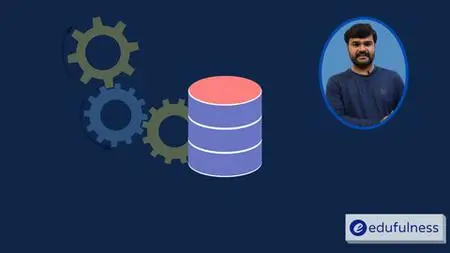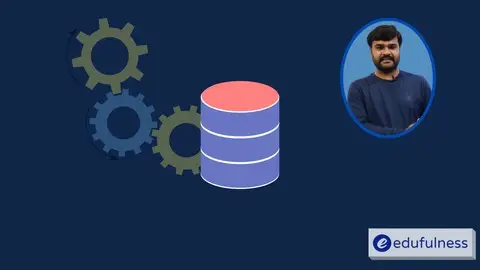Database Management System (DBMS) & SQL : Complete Pack-2022 (Updaet)
Last updated 2/2022
MP4 | Video: h264, 1280x720 | Audio: AAC, 44.1 KHz
Language: English | Size: 7.86 GB | Duration: 16h 0m
Last updated 2/2022
MP4 | Video: h264, 1280x720 | Audio: AAC, 44.1 KHz
Language: English | Size: 7.86 GB | Duration: 16h 0m
Database Engineering (RDBMS) : ER model,FD's,Normalization,SQL,ACID,Transactions & Concurrency Control, Indexing & more.
What you'll learn
Describe the fundamental elements of relational database management systems.
Explain the basic concepts of relational data model, entity-relationship model, relational database design, relational algebra and SQL.
Design ER-models to represent simple database application scenarios
Improve the database design by normalization.
Concurrency control( from scratch to advance).
Database indexing ( B and B+ Trees).
Able to create complex SQL queries using multiple tables.
In-depth knowledge over database design or database engineer.
Learn core concepts of database design.
Capable to answer any level of competitive exams like GATE, ISRO, PSU's or any other.
Requirements
No Prerequisites.
Description
_______________________________________________________________|**** Visit my website for better offers in instructor profile. ****|–––––––––––––––––––––––––––––––––––––Welcome to the course "Database Management System(DBMS) & SQL : Complete Pack 2022".If you want learn RDBMS concepts from scratch to advance level then confidently I can say that you are in right place. Here every topic taught from very basic and all possible insights discussed from each corner for every topic along with many examples for better understanding. Definitely you will master database concepts by the end of the course and you will become good database engineer. Course Objectives: The objective of the course is to present an introduction to database management systems, with an emphasis on how to organize, maintain and retrieve - efficiently, and effectively - information from a DBMS. Learning Outcomes: Upon successful completion of this course, you should be able to: • Describe the fundamental elements of relational database management systems • Explain the basic concepts of relational data model, entity-relationship model, relational database design, relational algebra and SQL. • Design ER-models to represent simple database application scenarios • Convert the ER-model to relational tables, populate relational database and formulate SQL queries on data. • Improve the database design by normalization. • Familiar with basic database storage structures and access techniques: file and page organizations, indexing methods including B tree, and hashing.UNIT- I Database System- concepts and architecture: Data modelling using the Entity Relationship (ER) modelling and Enhanced Entity Relationship (EER) modelling, Specialization and Generalization. UNIT-II The Relational Model: Relational database design using ER to relational mapping, Relational algebra and relational calculus, Tuple Relational Calculus, Domain Relational Calculus, SQL. UNIT-III Database design theory and methodology: Functional dependencies and normalization of relations, Normal Forms, Properties of relational decomposition, Algorithms for relational database schema design. UNIT-IV Transaction processing concepts: Schedules and serviceability, Concurrency control, Two Phase Locking Techniques, Optimistic Concurrency Control, Database recovery concepts and techniques. UNIT-V Data Storage and indexing: Single level and multi level indexing, Dynamic Multi level indexing using B Trees and B+ Trees.Important information before you enroll!Once enrolled, you have unlimited, 24/7, lifetime access to the course (unless you choose to drop the course during the first 30 days).You will have instant and free access to any updates I'll add to the course - video lectures, additional resources, quizzes, exercises.You will benefit from my full support regarding any question you might have 7 days a week.Check out the promo video at the top of this page and some of the free preview lectures in the curriculum to get a taste of my teaching style and methods before making your decision.Come and join me, you will get definitely great learning experience and you will master the course. Thank you.|––––––––––––––––––––––––––––––––––––––––––––––––––-||******** ALL THE BEST FOR YOUR BRIGHT FUTURE ********| |––––––––––––––––––––––––––––––––––––––––––––––––––-
Overview
Section 1: Keys : Candidate key, Primary key, Super key, Foreign Key.
Lecture 1 Types of keys.
Lecture 2 Candidate Key
Lecture 3 Primary Key
Lecture 4 Alternate Key
Lecture 5 Super Key
Lecture 6 Foreign Key
Section 2: Entity - Relationship Model ( ER Model).
Lecture 7 Introduction.
Lecture 8 Entity : Strong and Weak Entity.
Lecture 9 Attribute : Key attribute, Simple and Composite Attributes.
Lecture 10 Attribute : Single and Multi-valued Attributes & Stored and Derived Attributes.
Lecture 11 Relationship : Introduction, Weak Relationship.
Lecture 12 Relationship : Degree - Unary, Binary, Ternary and n-ary Relationships.
Lecture 13 Relationship:Cardinality-One:One(1:1),One:Many(1:M),Many:One(M:1),Many:Many(M:M)
Lecture 14 Relationship : Partial and Total Participation & Cardinality Ratio.
Lecture 15 Example 1,2 : Min,Max Cardinality, Partial & Total Participation, Relationship.
Section 3: Functional Dependency (FD).
Lecture 16 Functional Dependency : Introduction, Examples
Lecture 17 Types of Functional Dependencies : Trivial and Non-Trivial FD's.
Lecture 18 FD : Example.
Lecture 19 Inference Rules
Lecture 20 Attribute Closure : Example 2
Lecture 21 Attribute Closure : Example 3
Lecture 22 Attribute Closure : Example 4
Lecture 23 Applications of Attribute Closure
Lecture 24 Application 1 : Finding additional FD's
Lecture 25 Application 2 : Finding keys in a relation - Example 1 & 2.
Lecture 26 Application 2 : Finding keys in a relation - Example 3 & 4.
Lecture 27 Application 2 : Finding keys in a relation - Example 5 & 6.
Lecture 28 Application 2 : Finding keys in a relation - Example 7 & 8.
Lecture 29 Application 2 : Finding keys in a relation - Example 9 & 10.
Lecture 30 Application 2 : Finding keys in a relation - Example 11 & 12.
Lecture 31 Application 2 : Finding keys in a relation - Example 13 & 14.
Lecture 32 Application 3 : Equivalence of Functional Dependencies - Example 1
Lecture 33 Application 3 : Equivalence of Functional Dependencies - Example 2
Lecture 34 Application 3 : Equivalence of Functional Dependencies - Example 3
Lecture 35 Application 3 : Equivalence of Functional Dependencies - Example 4
Lecture 36 Application 4 : Irreducible set and Algorithm.
Lecture 37 Application 4 : Irreducible set - Example 1
Lecture 38 Application 4 : Irreducible set - Example 2.
Lecture 39 Partial Functional Dependency and Full Functional Dependency.
Lecture 40 Anomalies : Update, Deletion and Insertion Anomaly.
Section 4: Normalization
Lecture 41 Normalization : Introduction and types.
Lecture 42 First Normal Form (1NF).
Lecture 43 Second Normal Form ( 2NF).
Lecture 44 2NF : Examples - 1, 2, 3, 4 and NOTE.
Lecture 45 Third Normal Form ( 3NF).
Lecture 46 3NF : Examples - 1, 2.
Lecture 47 3NF : Example - 3.
Lecture 48 3NF : Example - 4.
Lecture 49 Boyce Codd Normal Form ( BCNF).
Section 5: Structured Query Language ( SQL ).
Lecture 50 SELECT statement structure and evaluation order.
Lecture 51 SELECT clause Syntax and examples.
Lecture 52 DISTINCT keyword in SELECT clause.
Lecture 53 WHERE clause : Introduction.
Lecture 54 WHERE clause : Operators.
Lecture 55 WHERE clause : Logical Operators - AND, OR, NOT.
Lecture 56 WHERE clause : AND, OR, NOT - Together.
Lecture 57 ORDER BY clause : ASC, DESC
Lecture 58 LIKE and Wildcard Operators.
Lecture 59 NULL values and IS NULL & IS NOT NULL.
Lecture 60 Aggregate Functions : SUM(), AVG(), MIN(), MAX().
Lecture 61 Aggregate Functions : COUNT().
Lecture 62 GROUP BY clause.
Lecture 63 GROUP BY clause : Multiple columns
Lecture 64 HAVING clause and rules.
Lecture 65 Set Manipulation Operators : Rules.
Lecture 66 Set Manipulation Operators : UNION, INTERSECTION, MINUS.
Lecture 67 Joins : Introduction, Cross Join.
Lecture 68 Joins : Theta Join / Conditional Join.
Lecture 69 Joins : Equi Join.
Lecture 70 Joins : Natural Join.
Lecture 71 Joins : Self Join
Lecture 72 Outer Join : Introduction.
Lecture 73 Joins : Left Outer Join
Lecture 74 Joins : Right Outer Join
Lecture 75 Joins : Full Outer Join
Section 6: SQL : Queries for better understanding.
Lecture 76 Query : 1,2,3.
Lecture 77 Query : 4.
Lecture 78 Query : 5.
Lecture 79 Query : 6, 7.
Lecture 80 Query : 8.
Lecture 81 Query : 9.
Lecture 82 Query : 10.
Lecture 83 Query : 11.1, 11.2, 11.3, 11.4.
Section 7: Relational Algebra (RA) and Relational Calculus (RC).
Lecture 84 Relational Algebra : Introduction.
Lecture 85 RA : Selection and Projection Operators.
Lecture 86 RA : Set Manipulation Operators(Union, Intersection, Difference)
Lecture 87 RA : Set Manipulation Operators - UNION
Lecture 88 RA : Set Manipulation Operators - INTERSECTION.
Lecture 89 RA : Set Manipulation Operators - SET DIFFERENCE.
Lecture 90 RA : Cartesian Product.
Lecture 91 RA : Rename Operator.
Lecture 92 RA : Join introduction and Types.
Lecture 93 RA : Conditional Join / Theta Join
Lecture 94 RA : Equijoin
Lecture 95 RA : Natural Join.
Lecture 96 RA : Outer Join
Lecture 97 RA : Left Outer Join
Lecture 98 RA : Right Outer Join
Lecture 99 RA : Full Outer Join
Lecture 100 RA : Division Operator.
Lecture 101 RA : Division Operator - Example 1, 2.
Section 8: Transactions and Concurrency Control.
Lecture 102 Transaction : Introduction
Lecture 103 Schedule : Serial and Concurrent Schedules - Definitions.
Lecture 104 Problem : Number of Searial and Concurrent Schedules.
Lecture 105 1. Last update problem : Problems due to concurrency control.
Lecture 106 2. Dirty Read Problem : Problems due to concurrency control.
Lecture 107 3. Unrepeatable Read Problem : Problems due to concurrency control.
Lecture 108 Problem
Lecture 109 Non-recoverable Schedules.
Lecture 110 Recoverable Schedules.
Lecture 111 Cascading Schedules.
Lecture 112 Cascadeless Schedules.
Lecture 113 Strict Schedules
Lecture 114 Relation among Strict, Cascadeless and Recoverable Schedules.
Lecture 115 Problem : 1, 2.
Lecture 116 Problem : 3.
Lecture 117 Problem : 4.
Lecture 118 Problem : 5, 6.
Lecture 119 Problem : 7, 8.
Lecture 120 Classification
Lecture 121 Serializability : Introduction
Lecture 122 Serializability : Number of serial and non-serial schedules.
Lecture 123 Serializability : Types
Lecture 124 test
Lecture 125 test1
Lecture 126 test2
Section 9: File Organization
Lecture 127 Introduction
Lecture 128 Storage Strategies : Spanned and Unspanned Strategies.
Lecture 129 Records organization in a file.
Lecture 130 Sparse Index and Dense Index.
Lecture 131 Indexing : Introduction.
Lecture 132 Indexing : Primary Indexing.
Lecture 133 Indexing : Primary Indexing - Numerical Problem.
Lecture 134 Indexing : Cluster Index.
Lecture 135 Indexing : Secondary Indexing.
Lecture 136 Indexing : Secondary Indexing - Example.
Section 10: Multi-level Indexing : B - Trees and B+ Trees.
Lecture 137 B-Tree : Introduction.
Lecture 138 B-Tree : Node structure.
Lecture 139 B-Tree : Order of Node.
Lecture 140 B-Tree : Numerical problem on Order of node.
Lecture 141 B-Tree : Tree creation with example.
Lecture 142 B-Tree : Deletion operation with example.
Lecture 143 B+ Tree : Introduction - Structure, Order of Leaf and Internal Node.
Lecture 144 B+ Tree : Leaf node and Internal node Split.
Lecture 145 B+ Tree : Insertion Operation - Tree Creation.
Lecture 146 B+ - Tree : Numerical problem on Order of node.
Academic Students,Competitive Exams Aspirants,GATE CS/IT,Willing to Learn,Database Engineer,Database Designer



